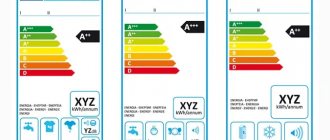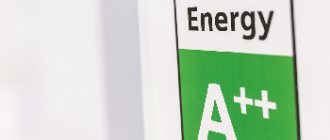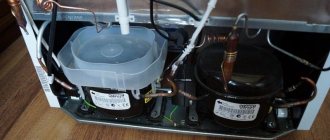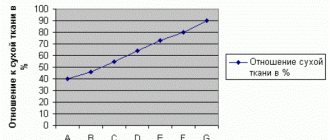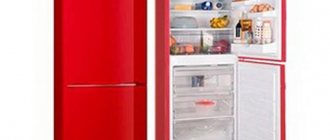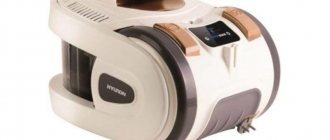Decoding the electricity consumption of refrigerators
Typically, refrigerators add up to 15% of your monthly energy bill. Household refrigerators could consume between about 100-200 watts of electricity per month. However, it is important to understand that refrigerators do not use energy constantly. Electricity is consumed when the compressor needs to turn on or when the interior is exposed to outside temperatures. Thus, based on several factors, including the brand of the refrigerator, energy consumption can be calculated.
You can use a power meter to check the refrigerator's performance, or you can calculate the power consumption manually. All you need to know is the average power consumption of the refrigerator. This can be achieved by dividing the annual consumption rate stated on the label by the number of days used.
For example: annual power consumption = 830 kWh
Number of working days = 360
Average refrigerator power = 2.3 kW / 2300 W per day.
Criterion importance
Along with the power of the compressor and the volume of the freezer, the energy consumption of the refrigerator is the most important parameter that must be taken into account by the consumer when choosing equipment. Why is it important? Unlike the entire range of household appliances, the refrigerator works around the clock, producing cold and consuming a certain amount of electricity for this work. Energy consumption indicates to the user the “gluttony” of the equipment. The production of hundreds of kilowatts of electricity consumed requires natural resources, which, unfortunately, are not unlimited.
By choosing a refrigerator with a high energy saving class, the consumer saves not only the family budget, but also the natural resources of the planet, no matter how pretentious it may sound.
On a note! The classification of energy consumption of modern refrigerators allows the consumer to conclude what financial costs it will cost to maintain the model.
Consumers often confuse the concepts of energy consumption and energy efficiency. Unlike “gluttony,” the energy efficiency index shows the relationship between the amount of energy consumed and the work done. In other words, how many kilowatts of electricity will the device spend to create and maintain standardized temperature indicators per unit of time.
Energy consumption class of household appliances
Manufacturers of household appliances pay special attention to the energy consumption of appliances. Energy characteristics are installed on household appliances in the form of a sticker. Currently there are 7 main energy consumption classes: A, B, C, D, E, F, G.
Where class A is very economical, and class G has high energy consumption. The class is assigned based on the kilowatts of electricity consumed by the equipment. Global brands are trying to reduce their customers’ electricity costs, thereby creating new subclasses A+, A++. Such models are the most economical on the market, and the G class has completely left the market.
Energy consumption class in the modern world is an important criterion that allows you to determine possible energy costs. By using highly efficient electrical appliances, you can reduce your energy bills. But such models cost a lot of money; you pay for the highest class, where modern and complex technological elements are installed.
That is why, before purchasing household appliances, you should pay close attention to the energy consumption class.
Refrigerator energy consumption class
The refrigerator runs all year round, and during these days the electricity bill adds up. Electricity prices are rising every year, and household appliances need to be maintained, so you should choose an economical refrigerator. That is why the energy consumption class of a refrigerator is an important parameter when choosing.
Manufacturers produce a large number of models with different energy consumption classes. The leaders are classes A and above. Subclasses A+, A++, A+++ have the lowest energy consumption; it is better to give your preferences to these models.
| Energy efficiency class | A+++ | A++ | A+ | A | B | C | D | E | F | G |
| Energy efficiency index | <22 | 22-33 | 33-42 | 42-55 | 55-75 | 75-95 | 95-110 | 110-125 | 125-150 | >150 |
Classes B, C and D are the average; there are fewer and fewer such models on the market, they occupy approximately 30% of the market. These models are not very power-hungry, but when compared with class A indicators, we will see clear advantages. These classes are expected to disappear from the market soon, which is what happened with refrigeration classes E, F, G. Such models have not been produced for a long time due to poor energy efficiency.
Washing machine energy consumption class
Manufacturers are releasing more and more modern and economical models that are available to many potential buyers. New modern technologies are being created that are replacing washing machines of class C and B. There are 7 main classes in washing machines. Class A is followed by more highly economical classes. A+ and A++ are the highest energy consumption classes for washing machines. Group F and G are still in the classification, but such models will be difficult to purchase; manufacturers give preference to more economical models.
| Class | A++ | A+ | A | B | C | D | E | F | G |
| Energy consumption when washing 1 kg of laundry (60° cotton) kW/h | < 0.15 | 0.17 | 0.17-0.19 | 0.19-0.23 | 0.23-0.27 | 0.27-0.31 | 0.31-0.35 | 0.35-0.39 | > 0.39 |
The energy consumption class is calculated taking into account the consumption of kWh of electricity per kilogram of laundry. The energy consumption of washing and drying machines is more difficult to determine, since it also depends on the rotation speed of the centrifuge and water consumption.
It is necessary to take into account the energy consumption class, but in conjunction with other parameters, characteristics, functions and advantages of a particular model. If you want to save money on operating your washing machine, we recommend purchasing models with energy consumption class A and higher.
If you are interested in purchasing high-quality and economical household appliances, our managers will help you choose the right model that meets your wishes and requirements.
We offer various models of washing machines and refrigerators at competitive prices, which you can view in our Catalog.
How is the energy efficiency of a refrigerator calculated?
Refrigerators are assigned this category for a reason. To do this, a complex formula is used that takes into account the dimensions of the unit, the temperature range, the annual level of electricity consumption and many other parameters.
The energy efficiency class of a refrigerator directly depends on the Energy Efficiency Index (EEI). And the index itself depends on the annual electricity consumption of the device.
The index values are given in the table:
How much does a refrigerator consume in kW per year?
You can calculate electricity consumption for the year taking into account the indicators per hour or daily, which are indicated in the technical specifications in the passport of the refrigeration equipment.
Modern household appliances sold on the domestic market consume about 220-460 kW annually.
However, there are other factors that influence the amount of electricity consumed during operation:
- Room temperature. The warmer the air in the room, the more electrical energy the refrigeration unit consumes to maintain stable cold in the compartments and freezer.
- The quality of seals in the doors of household appliances can indirectly affect the stability of maintaining low temperatures in the refrigerator. It is important to regularly replace sealing materials and check the reliability of the sash slamming.
- The frequency of use of household appliances affects the amount of electricity consumed. The highest consumption can be noted when the doors are opened every 1-2 hours. The unit will require more electricity to maintain sub-zero temperatures in the compartments.
- The presence of additional functionality in the model in the form of backlighting and an ice supply device increases energy consumption.
How much does a refrigerator consume per month and year?
Depending on the electrical efficiency class, the refrigerator consumes a certain amount of electricity.
In most cases, annual consumption is 240 - 470 kilowatts. From this number, monthly, weekly and daily energy consumption is calculated. To do this, simply divide the annual figure by the number of months or days.
For example, a refrigerator consumes 240 kilowatts per year. Then, in a month, 20 kilowatts will accumulate - 240 kW/h: 12 = 20 kW/h. Knowing the consumption of the device, you can find out the amount that its operation will cost. To do this, you need to multiply your annual, monthly or daily electricity consumption by the electricity tariff.
This indicator cannot be called accurate, since every day the refrigerator uses a different amount of energy, and we can only find out the average. This is due to various factors, such as room temperature. The higher the outside temperature, the more electricity the refrigerator consumes.
Costs are also affected by the load on the device, how often the door is opened and many other factors. You can find out the exact list of factors affecting the energy consumption of a refrigerator when purchasing a specific device or from the instructions.
If it happens that the instructions for the refrigeration unit have not been preserved and you cannot find out how much energy it consumes, then it is enough to find out the model class of the refrigerator. Approximate electricity consumption depending on the refrigerator class:
| Energy class | Electricity consumption, kWh/kg |
| A++ | |
| A+ | 0,17-0,15 |
| A | 0,17-0,19 |
| B | 0,19-0,23 |
| C | 0,23-0,27 |
| D | 0,27-0,31 |
| E | 0,31-0,35 |
| F | 0,35-0,39 |
| G | >0,39 |
In practice, you can determine how much a refrigerator consumes with a wattmeter (it costs about 1,000 rubles). About this video below.
Refrigerator power calculator
When calculating the capacity of a refrigeration unit, a problem may arise. The fact is that the compressor consumes most of the electricity, and it does not work all the time.
The device operates intermittently in accordance with a similar plan: freon circulates in the circuit until the thermostat fixes the desired temperature, then the compressor turns off. calculate the approximate power of a household refrigerator using a calculator:
Indicators on the energy efficiency sticker
The energy efficiency classes of household refrigerators are reflected on a special sticker that is attached to the device. Let's look at the data reflected in it from top to bottom.
- Manufacturer and model of the device.
- Graphic scale indicating the energy efficiency class to which this model belongs.
- Energy consumption per year. A specific figure is indicated in kW/h.
- Useful volume of the refrigerator compartment in liters.
- Useful volume of the freezer compartment in liters.
- Noise level.
Values on the sticker.
Look at the letter and color
The classification and labeling of household appliances by energy consumption level was invented in Europe back in the early 90s of the last century. In Russia, until recently, manufacturers were not required to indicate the energy consumption class of equipment. They were obliged to do this after the adoption of the Law “On Energy Saving” in 2009. The relevant resolution listed household appliances that are subject to mandatory labeling by energy consumption class from January 1, 2011. This list includes refrigerators, freezers, washing machines and dishwashers, air conditioners, electric stoves and ovens, microwave ovens, televisions, electrical heating appliances, electric water heaters and lamps.
As in Europe, the class of devices based on energy consumption is denoted in Latin letters. Initially, there were seven classes, and they were designated by letters from A to G: the most economical devices correspond to class A, the most consumable - G. In recent years, with the advent of even more energy-efficient modern technology, new classes of equipment for energy consumption have been added - A+, A+ +, Super A.
Letter markings are also accompanied by color markings. For example, class A is indicated by bright green, B by light green, D by yellow, and the lowest class G by red. All this information is contained on a special sticker that the manufacturer applies directly to the product (not to the packaging). The same data is duplicated in the device passport. So, it's not difficult to find them.
Another question is how does the consumer benefit from this information? What do the colors and letters mean in practice, and how significant is the difference in energy consumption between equipment of different classes? Refrigerators can be compared as an illustrative example. As a rule, they work around the clock, so they are among the most energy-intensive household appliances.
Comparative table of refrigerators by energy consumption classes
| Energy class | The ratio of the actual energy consumption of the refrigerator to the standard |
| A++ | Less than 30% |
| A+ | 30…42% |
| A | 42…55% |
| B | 55…75% |
| C | 75…90% |
| D | 90…100% |
| E | 100…110% |
| F | 110…125% |
| G | more than 125% |
As can be seen from the table, refrigerators of classes D and E most correspond to the regulatory (standard) level of energy consumption. At the same time, a refrigerator of class A++ - with the best energy efficiency index - is more than three times more economical. Other types of household appliances will have a similar ratio of energy consumption indicators between classes. The general conclusion is that the higher the energy consumption class of the equipment, the less electricity it burns during operation. And the lower the owner’s expenses for electricity supply.
Classes A, A+, A++
At first, there was a division into seven classes - from A to G, starting from the most economical. Already in the 2000s, subclasses A+ and A++ were additionally introduced. We will talk about them separately, since refrigerators with such markings are among the least voracious, and they are also the most common today.
- A++ = 30%;
- A+ = 42%;
- A = 55%.
Refrigerators belonging to energy consumption classes A, A+, A++ currently occupy approximately 70% of the market.
If efficiency is a priority for you, and electricity bills make you shiver, then definitely buy a refrigerator of class A or higher. But before purchasing, do not be lazy and compare the cost of electricity with the price of a household appliance. Perhaps in your case there will be no savings, or they will appear after 30 years of operation.
What is energy class
In European countries and the Russian Federation, there are state regulations obliging manufacturers to indicate the energy saving class. To notify the consumer about the technical characteristics of the device, each equipment is marked with a color and a letter.
The range of letters is from A to G. The index shows the degree of efficiency, where A is the most efficient, G is resource-intensive. The letter is placed on a colored background from red to green. The colder the shade, the more energy efficient the refrigeration unit, and, accordingly, the lower the cost of its operation.
The highest class is marked with a dark green tint.
The energy consumption class depends on the type of household appliance. The actual energy consumption of a refrigerator and a washing machine classified in the same energy efficiency class will vary.
Classes B, C, D
Refrigerator energy consumption classes B, C and D are a category with average efficiency indicators. It cannot be said that household appliances with this marking are so voracious, but they are outright inferior to competitors of class A and higher:
- B = 75%;
- C = 90%;
- D = 100%.
At the moment, refrigerators with energy consumption classes B, C, D occupy less than 30% of the market. Probably very soon they will disappear from sales altogether and will remain only on the used model market. After all, this is exactly what happened with refrigerators of classes E, F, G - due to poor energy efficiency, their production has long been discontinued.
Refrigerators of classes E, F, G have not been in mass production for 30 years.
Of course, it is imperative to take into account whether a model belongs to a particular class of energy consumption, gluttony, or refrigerators. It is better to give preference to models marked A, A+ or A++.
What are the classes?
Freezers are available in different classes:
- A;
- B;
- C;
- D.
The parameter is reflected on a sticker on the panel of the refrigerator or in the instructions for household appliances. The class belonging of the unit is calculated using a complex formula, taking into account the following technical characteristics of the refrigerator:
- dimensions;
- range of temperature conditions installed in the unit;
- annual electricity consumption rate;
- number of cameras (from 1 to 3 or double-sided Side by Side models);
- refrigerator climate zone;
- manual or automated defrosting system;
- type of compressor;
- the presence of a dispenser or ice maker, etc.
View » Rating of the best refrigerators with the No Frost system: how to choose a good two-chamber
They determine which energy consumption class is better, depending on the user’s tasks, the number of family members, and the size of the kitchen. The degree of load in the refrigerator compartments, etc., affects the consumption of electrical energy.
Classes A
Level A refrigeration equipment is among the most modern and energy efficient. In the list of subclasses A:
- A;
- A+;
- A++;
- A+++.
Freezing equipment of subclasses A accounts for more than 70% of the total products on the refrigerator market. The units have slight differences in power and energy consumption features; model A+++ is 2 times more economical than a class A unit.
During the operating cycle, refrigerator models consume depending on the type:
- A - up to 48.5-55%;
- A+ - within 37.5-42%;
- A++ - up to 27.5-30%;
- A+++ - less than 22%.
However, when purchasing a model, the dimensions and number of cameras are also taken into account. Equipment of the highest category is compact and is used as a standard for freezing products.
Classes B, C, D
Refrigerators of classes B, C and D are less economical in electricity consumption. Models of level B, according to experts, are the most profitable to purchase and operate.
Electricity consumption is distributed according to the following data:
- B - within 65%;
- C - up to 85%;
- D—exceeds 110%.
Models of categories C and D are recognized as uneconomical in the consumption of electricity, which is why many manufacturers are consistently removing the designs from production.
Refrigeration equipment models with subcategories E, F and G are no longer produced due to technical obsolescence.
Table
The table shows the technical characteristics of refrigerators of different categories.
| Electricity consumption category | Characteristic | Energy efficiency index |
| A+, B++, A+++ | Models save up to 50% of electricity | 22-44 |
| A, B | The equipment saves up to 35% of kilowatt-hours | 44-75 |
| C, D | Energy efficiency of equipment is low | 75-110 |
| F, G | Uneconomical freezing equipment, discontinued | 110-150 |
Rules for choosing a refrigerator
When choosing a refrigerator, you should consider not only the energy efficiency class, but also:
- chamber volume;
- possibility of changing the opening side;
- dimensions (not every refrigerator will fit through a doorway or fit into a kitchen);
- number of family members;
- presence of useful functions (ice generator, open door sensor).
A refrigerator is equipment purchased for years, so you should not make a hasty choice. Cost-effectiveness and energy efficiency of a refrigerator are synonymous. The refrigerator is used constantly; you can save money only by purchasing a model that consumes few resources.
Refrigerator Energy Saving Tips to Reduce Costs
Here are some simple yet great energy saving techniques to reduce and keep your maintenance costs low.
Keep your temperature settings under control
The temperature level of your refrigerator plays a crucial role in determining your energy bill. Maintaining unnecessary cold temperatures can increase energy consumption and, in turn, your bill. The ideal temperature of a refrigerator should be between 2-4℃, while the freezer should always maintain a temperature between -16℃ and -18℃. If the temperature inside the refrigerator is too high or too low, there is a high chance that your food will also spoil.
If you need to check the temperature inside the device, place the thermometer in a glass of liquid (water) and leave it for 24 hours. Similarly, place a thermometer between two frozen ice cubes or any food item for 24 hours to check the freezer temperature.
Keep your refrigerator stocked with food
Yes, as strange as it may sound, the more you store in your refrigerator, the more efficiently you use it. However, overcrowding should be avoided by allowing air to circulate evenly throughout the refrigerator. A loaded refrigerator maintains the ideal temperature better than an empty one. If your refrigerator is almost empty, fill it with containers of water or other liquid.
This will improve the performance of the device. It is also important to cover all containers and other food items before storing them. Opened food tends to dry out, and the loss of moisture in turn makes it harder for the compressor to operate, which impacts energy consumption.
Place your refrigerator correctly
The installation of a refrigerator makes a huge difference in determining its efficiency. These types of appliances need some space around them to help with air circulation. Overcrowding the space by placing it between cabinets or storage can hinder its performance.
Additionally, it is important not to keep refrigerators near any heat-producing objects such as an oven, stove, etc. Placing them in direct sunlight is also not recommended. The temperature around the refrigerator may require 20% more electricity.
Regular Maintenance
Refrigerators have metal condenser coils located at the back that help get rid of the heat generated by the compressor. Keeping the coils clean is an important step to ensure your refrigerator lasts long and performs efficiently. Cleaning them once a year should prevent overloading the compressor. Whether you have a refrigerator with automatic defrosting or you have to do it manually, make sure your refrigerator goes through a regular freeze and defrost cycle to improve its efficiency.
Ice accumulation in the evaporator should not exceed 6 mm. The greater the ice accumulation, the greater the energy required to keep the engine running.
Activate the refrigerator's energy saving mode
Most modern refrigerators come with an energy-saving mode. Older models used heaters to prevent condensation inside the unit when the door was opened and the cold air in the refrigerator was cooled. New appliances with energy-saving mode reduce the need for a heater and, in turn, the need for additional energy consumption.
From A+++ to G: energy efficiency classes of household appliances
During the implementation phase, energy efficiency classes were designated by symbols A to G on a colored background (green to red). This marking is easy to decipher: the closer the letter is to the beginning of the alphabet, the more efficient the device’s energy consumption
. Subsequently, it was possible to exclude the symbols E, F and G from most categories due to their withdrawal from the market due to high wastefulness and introduce a couple of new indices: A+, A++ and A+++, identifying devices with maximum energy efficiency.
| The place of the wasteful symbols E, F and G in the marking of energy efficiency classes has been taken by the more current indices A+, A++ and A+++. |
A mark indicating the energy efficiency class of household appliances is placed on refrigerators, dishwashers, washing and drying machines, ovens, hoods, televisions, air conditioners, vacuum cleaners, water heaters and even some types of light bulbs (with a luminosity of 6500 lumens and a power of over 4 W). You can find the treasured letter on an information sticker or in the characteristics of a particular device (including using filters to search in household appliance catalogs). The Energy Label sample has been approved by the European Association of Household Appliance Manufacturers (CECED). The main thing on them is the indication of the energy consumption class on the corresponding color background.
At the same time, the label indicates the key performance characteristics of the equipment, which vary depending on the category of device. For different groups of equipment, the energy efficiency scale is calculated according to different criteria. We will look at them:
Refrigerators and freezers
Food storage plays one of the most important roles in the house. Their energy consumption is important like no other. The thing is that refrigerators and freezers work non-stop, i.e. 24 hours a day, 7 days a week. The energy efficiency indicator of refrigerators is calculated taking into account the volume of the chambers, the minimum possible temperature inside them and the presence of additional options in the device.
It may well be that some giant refrigerator, although it consumes more electricity than its compact counterpart, nevertheless belongs to a higher class of energy efficiency.
The Energy Label also contains information about the brand and model of the refrigeration unit, annual energy consumption, internal volumes of the freezer and refrigerator compartments, and noise level in decibels. The most energy efficient refrigerators Gorenje NRC 6204 SXL5M from 16,380 UAH. Liebherr CP 4813 from 13,494 UAH. LG GB-B62SWGFN from 16,700 UAH. Bosch KGE49EICP from 21,695 UAH. Siemens KG49NAXDP from 28,355 UAH. Bosch KGE39AICA from 19,700 UAH. Liebherr CP 4313 from 12,328 UAH. LG GB-B61PZFFN from 16,723 UAH. Samsung RB36T602CSA from 17,373 UAH. LG GB-B72PZDFN from 20,131 UAH. Hisense RB-438N4GX3 from 13,882 UAH. Samsung RB38T672CWW from 22,368 UAH. Samsung RB36R8899SR from 27,500 UAH. Samsung RB36T672CS9 from 16,100 UAH. Liebherr CBNes 4898 from 75,039 UAH. Liebherr K 4330 from 24,800 UAH. Samsung RB38T775CS9 from 25,101 UAH. LG GB-B62SWFFN from 16,968 UAH. Beko RCNA 406E63 ZXBN from 20,457 UAH. LG GW-B509PSAP from 26,531 UAH.
Dishwashers
The calculation of the energy efficiency class of dishwashers is based on the ratio of actual electricity consumption to standard, which directly depends on the number of sets of dishes loaded into the device. also influenced by the efficiency classes of the washing and drying cycles separately
. The European Energy Label for dishwashers is marked with symbols A+++ to D.
In addition to the traditional model and energy efficiency class, the sticker informs the user about the annual energy consumption (kW/year), drying quality class (from A to G), nominal load (number of standard cutlery sets) and noise level in decibels.
The most energy efficient dishwashers
Hotpoint-Ariston HSFO 3T235 WC X from 8,828 UAH. Candy Brava CDPN 4D620PX from 13,422 UAH. Bosch SMS 4EVW14E from 16,989 UAH. Siemens SR 23HI65 from 12,943 UAH. Bosch SMS 88UI36E from 26,934 UAH. Candy Brava HCF 3C7LFX from 9,169 UAH. Beko DFS 28131 X from 13,362 UAH. Beko DFN 38530 X from 17,893 UAH. Samsung DW60R7050FS from 16,508 UAH. Bosch SPS 6ZMI35E from 17,985 UAH. Bosch SMS 4EVI14E from 14,333 UAH. Candy Brava CDPMN 4S622PX from 17,893 UAH. Siemens SR 256I01 from 17,190 UAH. Siemens SN 278I36 from 27,693 UAH. Gorenje GS65160W from 13,647 UAH. Candy Brava HCF 3C7LFW from 9,499 UAH. Bosch SMS 88TI07E from 25,169 UAH. Siemens SN 26V896 from 23,248 UAH. Siemens SR 25ZI11 from 17,739 UAH. Beko MDFN 26431 X from 12,673 UAH.
Washing machines
For a group of “washing machines”, the energy efficiency class is determined by the ratio of power consumed per hour to the maximum weight of loaded laundry
. Previously, the label also included data on the washing efficiency class, however, according to the new CECED rules, all washing machines with a load of more than 3 kg of laundry are required to have the only possible washing class A.
Related information on the label includes the full name of the washing machine model, annual energy and water consumption, maximum load of laundry (in kg), spin efficiency class (from A to G), noise level during washing and spinning (separately for each procedure).
The most energy efficient washing machines
Samsung WW60J32G0PW from 9,292 UAH. Whirlpool TDLR 65230 from 7,800 UAH. Samsung WW80R42LHFWD from 11,599 UAH. LG FH0J3NDN0 from 8,920 UAH. Beko WUE 6511 XAW from 5,899 UAH. Whirlpool TDLR 6030 L from 6,799 UAH. Electrolux PerfectCare 600 EW6S4R27W from 7,099 UAH. Samsung WW60J42E0HW from 10,398 UAH. LG F2J3WS2W from 9,009 UAH. LG F2J3HN1W from 9,899 UAH. Bosch WAN 28162 from 10,318 UAH. Samsung WW60K42101W from 9,999 UAH. Electrolux PerfectCare 600 EW6T4062U from 10,590 UAH. Electrolux PerfectCare 600 EW6S426BUI from 7,879 UAH. Samsung WW80R42LHFXD from 11,999 UAH. LG F2J6HSW1W from 10,811 UAH. Electrolux PerfectCare 600 EW6S4R06W from 6,479 UAH. LG AI DD F2V5HS1W from 12,899 UAH. Samsung WW60J30G0LW from 8,775 UAH. Gorenje WE 62 SDS from 7,379 UAH.
Dryers
Close relatives of washing machines can be marked with one of three stickers: for models with ventilated drying, condenser drying and rare models powered by gas, their own version of the label is provided
. For example, the energy efficiency class of condensation dryers is determined based on information about the energy consumption of the machine when running the “Cotton” program with a full and partial load, as well as in standby mode and in a completely off state.
A set of extended information on the tag contains data on the brand of the dryer, its type, annual energy consumption, the duration of the “Cotton” program at maximum load of laundry, full load (in kg), noise level in decibels and moisture condensation efficiency class (symbols from A to G).
The most energy efficient dryers
Samsung DV90T6240LX from 14,899 UAH. Samsung DV90T5240AT from 15,399 UAH. LG RC80U2AV4D from 20,089 UAH. Samsung DV90T8240SH from 20,762 UAH. LG RC90V9AV3Q from 26,432 UAH. Bosch WTR 87TW0 from 17,487 UAH. LG RC90V9AV2Q from 27,893 UAH. Siemens WT 47XEH1 from 31,285 UAH. Gorenje DE 83 GI from 15,849 UAH. Bosch WTX 87MH0 from 22,955 UAH. Electrolux PerfectCare 900 EW9H1R88SC from 26,410 UAH. Samsung DV90M6200CW from 19,399 UAH. Siemens WT 47RTE0P from 19,665 UAH. LG DC90V9V9W from 27,205 UAH. AEG T9DBA68SC from 29,882 UAH. Electrolux PerfectCare 900 EW9H189BP from 36,824 UAH. Asko T408HD from 39,520 UAH. Bosch WTR 87TES from 22,595 UAH. Bosch WTW 876S0 from 19,300 UAH. Bosch WTX 87M30 from 25,500 UAH.
Ovens
One of the central places in most kitchens is the oven. Its energy efficiency class is determined based on the power and volume of the oven chamber.
Models with an internal volume of less than 18 liters, as well as ovens with a microwave function and steam ovens are not subject to marking.
Along with the energy efficiency scale on the label, you can see data on the name of the oven model, electricity consumption per cycle in static heating mode and in convection mode (kWh), useful internal volume of the oven in liters.
The most energy efficient ovens
Hoods
The list of kitchen appliances that are subject to mandatory “branding” is completed by hoods. The energy labeling system for them was adopted not so long ago - in 2014.
The label on the hood can tell you both about quite obvious things (model name and energy efficiency class of the device) and about a number of useful performance characteristics. The pictrograms on the sticker contain information about the annual energy consumption at a typical load, efficiency classes for removing evaporations from the hob, lighting and grease collection, as well as the noise level during operation of the hood (measured in decibels).
TVs
In everyday life, television is still the center of attraction for household members and the multimedia center of the home. Its energy efficiency is calculated as the ratio of power consumption to screen area
.
The energy efficiency scale contains information about the presence of a switch on board the device to completely de-energize the device, indicators of energy consumption in standby mode and for the year in the on state are indicated, and finally, the bottom of the sticker contains information about the diagonal of the TV display.
Air conditioners
With climate control technology, which provides coolness in the hot summer heat and warms with warm air currents in the off-season, things are somewhat more complicated. It all depends on the set of operating modes (cooling with or without heating), the type of cooling (air or water) and the configuration of the air conditioner
(split and multi-split systems, two-channel and single-channel systems with forced ventilation, etc.). Air conditioner efficiency measurements are made at outside temperatures from +20 °C to +35 °C (in increments of 5 °C), and for the heating mode, the climatic zone in which the equipment is supposed to be operated is taken into account.
A set of additional information on the label includes information about the annual electricity consumption, the type of air conditioner, its power when operating for heating and cooling, and the noise level of the outdoor and indoor units.
The most energy efficient (cooling) air conditioners
Cooper&Hunter Nordic Premium CH-S09FTXN-PW from 17,693 UAH. Cooper&Hunter Supreme Continental CH-S12FTXAL from 21,114 UAH. Cooper&Hunter Supreme Continental CH-S09FTXAL from 20,366 UAH. Cooper&Hunter ICY III CH-S12FTXTB2S-NG from 26,887 UAH. Haier Flexis AS25S2SF1FA/1U25S2SM1FA from 15,965 UAH. Cooper&Hunter Nordic Premium CH-S12FTXN-PW from 21,313 UAH. Midea BreezeleSS+ FA-12N8D6-I/FA-12N8D6-O from 17,799 UAH. Cooper&Hunter ICY III CH-S09FXTTB2S-NG from 24,070 UAH. Cooper&Hunter Vip CH-S12FTXHV-B from 27,532 UAH. Midea BreezeleSS+ FA-09N8D6-I/FA-09N8D6-O from 16,999 UAH. Haier Flexis AS35S2SF1FA/1U35S2SM1FA from 18,880 UAH. Mitsubishi Electric Deluxe MSZ-FH25VE/MUZ-FH25VE from 30,822 UAH. Mitsubishi Electric Deluxe Zubadan MSZ-FH25VE/MUZ-FH25VEHZ from 37,370 UAH. Mitsubishi Heavy Premium SRK20ZS-W from 21,600 UAH. Bosch CL5000i RAC 2.6 from 12,929 UAH. Cooper&Hunter Supreme CH-S09FTXAM2S from 28,356 UAH. Gree Amber GWH12YD-S6DBA2A from 24,595 UAH. Midea Oasis Plus OP-09N8E6 from 18,600 UAH. Mitsubishi Electric Premium MSZ-LN25VG/MUZ-LN25VG from 32,788 UAH. Mitsubishi Electric Deluxe Zubadan MSZ-FH35VE/MUZ-FH35VEHZ from 39,607 UAH.
Vacuum cleaners
Home front cleaners are among the appliances for which energy efficiency labeling was introduced in 2014. It looks like this:
The data on the label includes the appliance's annual energy consumption, indoor dust re-emission class (A to G), noise level in decibels, and cleaning efficiency classes for hard floors and carpets.
respectively.
Water heaters
Energy labeling is used both for autonomous boilers and boilers, and for complex devices
which are supposed to be used in combination with additional heating equipment. The sticker for devices of this type covers, perhaps, the maximum possible parameters.
The marking on the label with the water heater contains information about the brand and model of the product, the presence of heating and water heating functions in the device’s assets, the seasonal energy efficiency class of water heating for heating and the hot water supply circuit, the rated thermal power and the generated noise level in decibels.
As you can see, each type of household appliance has its own specifics. Our advice to you: focus on devices of class A and higher
. By paying attention to the energy efficiency indicator when choosing home appliances, you can furnish your home with economical models, thus reducing energy costs in the foreseeable future.
Types of models
In order to clearly understand all the energy saving labels of refrigerators, we decided to select the most relevant and popular models at an affordable price:
- As mentioned above, the favorites among all classes are the A++ models. They consume less electricity; such devices are most often single-chamber, the cost of which ranges from 19 thousand rubles. The most popular model in this class is the LiebherrKTPes 1554 (consumes only 127 kW/hour). The main competitors of this refrigerator model, the volume of which is 137 liters, are freezers. But unlike LiebherrKTPes 1554, they consume significantly more electricity, about 260 kW/h;
- We decided to include the S 86378 KG model from AEG as an A+ refrigeration device; the price range is from 45 to 55 thousand rubles. The energy consumption indicator is at least 315 kW/h per year. In addition to the manufacturer AEG, we decided to highlight the Samsung RL-44 QEUS, technical characteristics are almost identical, they consume the same amount of electricity;
- Unlike the previous two classes, A is more “demanding” in terms of the amount of electricity consumed, but the cost is no more than 21 thousand rubles. Representatives of this class include the Ariston MBA 2200, the total volume is 370 liters, energy consumption per year is at least 360 kW/h. The LiebherrCBNes 5067 is also located here, and the cost is quite high, about 70 thousand rubles, but the total volume is higher, and the electricity consumed is also greater, at least 460 kW/h;
- Unlike categories A+, A++, A, refrigerators marked B and C are significantly lower in cost, but, alas, they make the electricity meter spin faster. The most successful example of category B is the Gorenje RK 4295 E. Its cost does not exceed 20 thousand rubles, and it is two-chamber with a given volume of 275 liters;
- It is represented by the Biryusa 22 (KShD-2 55) refrigeration unit, it is also two-chamber, with a total volume of 255 liters. The cost is significantly lower, about 10 thousand rubles, but it will help you pay about 548 kWh per year.
What determines the efficiency of a refrigerator?
First, let's briefly look at how to choose an economical refrigerator. Here we will not discuss the selection of the volume of compartments, depending on the number of users, the defrosting system, etc., but will only touch upon the parameters that affect efficiency.
Energy efficiency class
When choosing a refrigerator that uses energy economically, you need to pay attention to the energy efficiency class. It is denoted in English by the letters A, B, C, etc. The higher the letter is to the beginning of the alphabet, the better. The most economical models are designated A+, A++, and A+++. For example, a unit with an A+ rating can consume 270 kW per year, and a refrigerator with an A++ rating can consume 200 kW.
But there is a direct connection with the volume of the chambers. After all, the larger the refrigerator and freezer compartments, the longer the compressor will have to pump freon to cool them. This means that it will spend more electricity. Therefore, sometimes you may encounter the following picture: a refrigerator with energy efficiency class A and a volume of 100 liters consumes 100 kW per year, and a model with class A++ and a volume of 400 liters consumes 300 kW per year. This is proportional and normal.
Compressor type
The type of compressor pumping refrigerant through the system also affects energy savings. This can be a classic (regular) unit or an inverter. The first one works intermittently (pumped up pressure and turned off). It can turn on dozens of times a day. In each case, the compressor of a two-chamber refrigerator consumes about 1.8 kW at start-up, although then the electricity consumption drops to 25-40 W/h. Inverter compressors do not stop, but only their operating frequency changes, so there are no high starting currents, which means the consumption of “light” is more economical. But models with an inverter compressor are more expensive.
Manufacturers of the most energy-saving models
Today, domestic consumers are most in demand for refrigeration equipment with energy consumption classes A, A+, A++, A+++. The leaders in the production of such equipment are foreign brands Siemens, Liebherr, Bosch, LG, Samsung, Whirlpool. In the budget segment, one can highlight energy-efficient equipment produced under the brands Nord, Ariston, Indesit and Atlant.
Examples of refrigerators.
